Llyn Brenig Reservoir (2020)
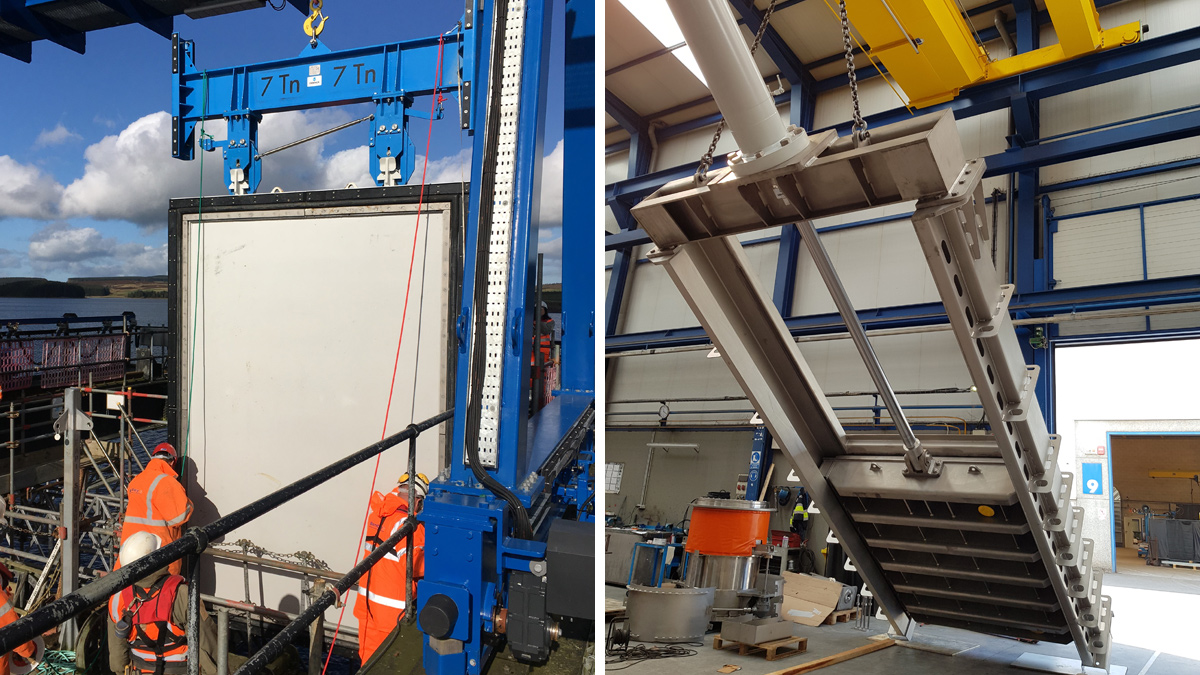
(left) Operation of new bulkhead and lifting beam and (right) new primary gate and frame at FAT inspections - Courtesy of Arup
Llyn Brenig impounding reservoir is located in the Denbigh Moors in North Wales. It was constructed in 1975 and was officially opened by the Prince of Wales. It forms part of the River Dee regulation to manage flow into the Dee via the Afon Alwen. The reservoir has a capacity of around 60 million cubic metres but has a relatively small catchment; the reservoir would take several years to refill if emptied. Further to recommendations were made in Llyn Brenig’s Statutory Reservoir Safety Inspection report of December 2015, Dŵr Cymru Welsh Water (DCWW) took the decision to make significant investment at the site to resolve these issues. This report describes some of the challenges faced on the project which required extensive works inside the tower, located remotely in the middle of a reservoir which needed to remain operational throughout the works.
Remedial work and refurbishment
Llyn Brenig’s Statutory Reservoir Safety Inspection report recommended DCWW undertake remedial work and refurbishment of the hydro-mechanical and electrical components of the scour works and to renew the electrical supply to the draw-off valves and include modifications to the system to allow draw-offs to be operated remotely. Additionally, DCWW had the following operational concerns:
- The single electrically actuated scour gate presented several single points of failure including the gate itself, the sealing system, the actuator, the drive shaft, and the drive bevel gearbox.
- Scour and emergency draw-down operations required several operatives to work from the top of the exposed draw-off tower located out in the reservoir and was reliant on the manual operation of an aging goliath crane restricted to weather conditions.
Background
The draw-off, scour and overflow systems are housed within a square 50m high concrete draw-off tower which sits remotely out in the reservoir at a depth of 47.5m relative to top water level. A crane sits on top of the tower exposed to the elements. Operational access to the tower is via a 300m long tunnel from the outlet works at the base of the dam where controls and standby power facilities are located. Access is also possible by boat.
The original scour system consisted of a 2.8m x 3.9m isolation bulkhead gate and a 2.4m x 2.5m electrically actuated roller gate; the bulkhead gate being used as a guard valve. To undertake a scour or emergency discharge, the bulkhead gate would first need to be lifted from the bottom of the reservoir using a manual latch and lift frame attached to the Goliath crane. An emergency free rolling sluice gate would then be lowered down the bulkhead guides from where it could be dropped to shut off flows in case of an emergency. The electrically actuated scour gate could then be operated against a maximum 47.5m head to control the discharge.
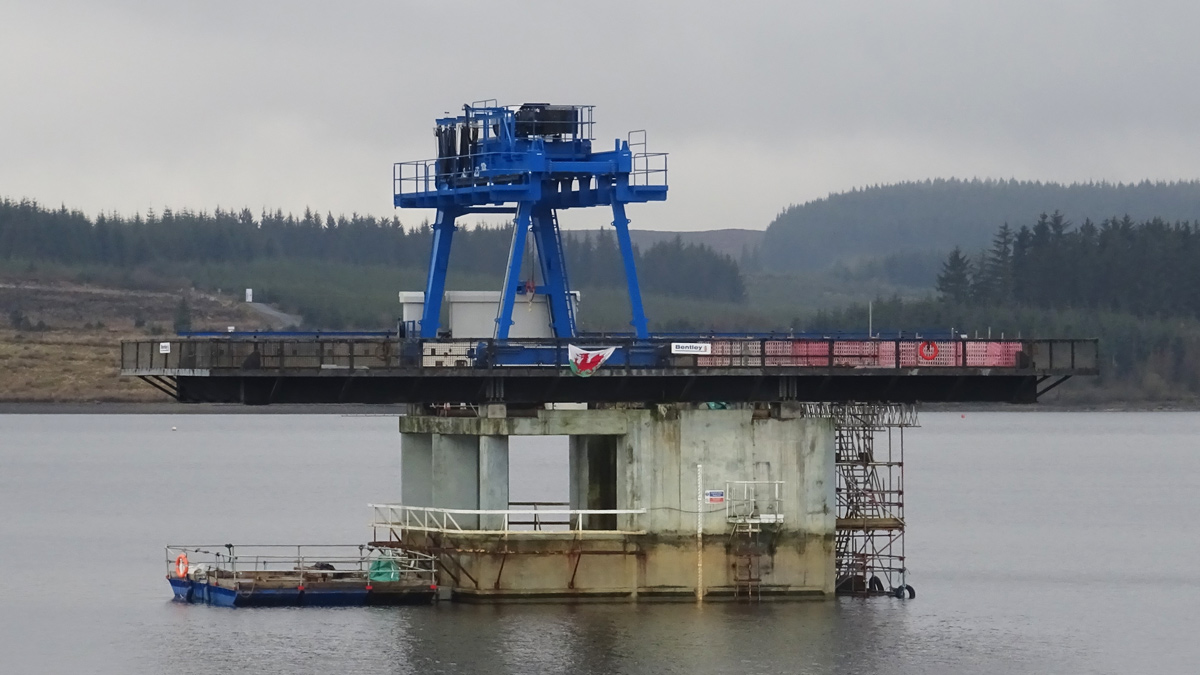
New gantry crane installed on tower – Courtesy of Arup
Design development
The key drivers for the design were as follows:
- To improve the reliability and robustness of the scour and emergency draw-off system.
- To remove the reliance on the gantry crane for emergency operations.
- To reduce the risks associated with single points of failure, as well as a general upgrade of the electrical supply and controls.
During the feasibility study and optioneering exercise, Arup investigated various options for removing the dependency on the crane for emergency works, and on removing the potential single points of failure. The final option was selected through a collaborative risk and value process and included:
- Replacement of the existing scour system assets with improved equipment, including full replacement of existing control gate, bulkhead gate and crane.
- Installation of new secondary scour gate to provide secondary isolation and remove single point of failure, thereby allowing the bulkhead gate to be stored at the top of the tower.
- Renewal of electrical cabling, actuators, control system and replacement of generator.
Bulkhead gate
The design criteria of the existing bulkhead gate could not be identified from available record information. The condition was known to be deteriorated, and the sealing system was performing poorly.
As this gate would act as the single point of isolation during works to replace the original scour gate and frame, the decision was made to provide a replacement bulkhead gate designed to a safety factor (SF) of 1.5 minimum for all load cases, with new seals and an improved bottom edge design to aid seating in the submerged slot at the base.
The design of the new bulkhead gate was proven by calculation to exceed the specified safety factor. Finite element analysis (FEA) considered various loading conditions, including partially seated and failed to close fully scenarios.
Gantry crane
The goliath crane was to be replaced with a new gantry crane of the same rating to allow safe remote operation using a wireless pendant. Arup completed a structural assessment on the existing gantry structure to identify its suitability for the proposed new crane plus the maximum payload at the extremes of travel. The structures anchor points and support plinths were to be upgraded.
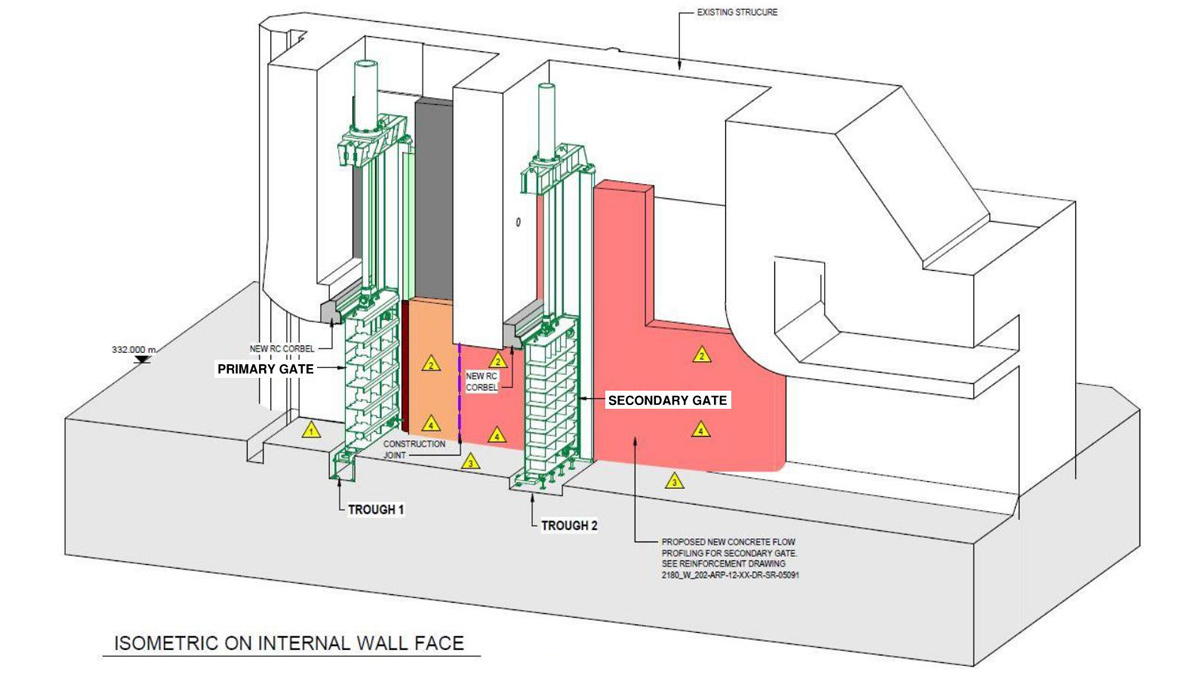
New scour system design overview – Courtesy of Arup
Primary scour gate
The existing scour gate was to be replaced with a new primary scour gate; a 2.4m x 2.5m hydraulically actuated fixed wheel roller gate fabricated in full stainless steel to extend the design life.
Although the initial proposal was based on replacement of the original scour gate only, on surveying and inspection of the normally inaccessible parts of the original frame, it was found to be of an outdated sealing design, and in such deteriorated condition on the upstream faces that it could not be modified or repurposed to provide an acceptable seal.
Arup undertook a thorough investigation of the record information to identify the details of the original frame and how it was tied into the structure and developed a procedure for its removal without compromising the structural reinforcement. The design of the new frame and anchoring arrangement needed incorporate the various requirements of transferring and distributing loads into the existing structure, constructability challenges, and ensuring reliable gate operation. The development of the gate and surrounding structural works design and construction sequence was therefore a thoroughly collaborative process between Arup, MMB and Orbinox (manufacturers of the gate).
Secondary scour gate
The new secondary scour gate would be installed a few metres downstream of the primary gate in an off-seating location. A hydraulically actuated roller gate was selected. As the main tower structure in the installation area could not be cut into whilst the tower was under pressure from the reservoir, this gate could not be recessed into the structure to allow a smooth flow profile.
Arup completed an initial computational fluid dynamics (CFD) study to prove the solution’s feasibility. During the detailed design, once the gate geometry was developed by Orbinox, a further CFD study was undertaken as part of their gate design to develop the profiling shape and reduce cavitation risk and risk of overtopping the culvert air vent.
The results of these profiling developments informed Arup’s structural design, which incorporated steel fabrications and concrete cast in situ to support the gate’s frame and anchor it to the original structure. Once again, this part of the design was driven also by the constructability challenges and was developed as a collaborative effort by both Arup’s structural team and MMB’s site operations teams to reduce and control the intrusive work on the existing structure.
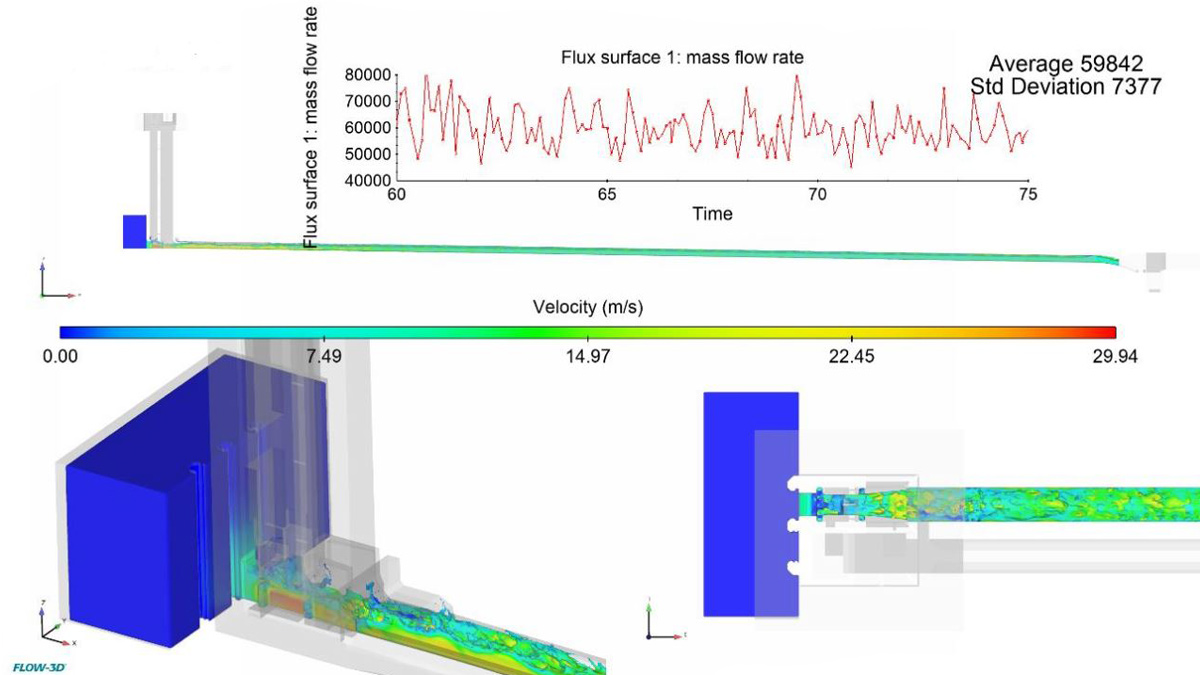
Extract from CFD report showing full discharge conditions – Courtesy of MMB
Electrical works
As well as providing power and control systems for the new equipment, all existing actuators on the draw-off system were replaced and associated cabling and control system upgraded. New control panels and MCCs were installed at the outlet works control room, allowing the main draw-off system and the scour/emergency draw-down system to be operated remotely from the control room. The standby diesel generator was upgraded for increased site demands.
Llyn Brenig Reservoir Remedial Work: Supply chain – key participants
- Lead designer: Arup
- Main contractor: Mott MacDonald Bentley
- Geotechnical investigation: Geotechnics Ltd
- Gates & hydraulic actuation design and supplier: Orbinox
- Gates & hydraulic actuation supplier: Glenfield
- Gate installation: Glenfield Invicta
- Mechanical installation: Flintshire Fabrications
- Electrical installation: Electromec
- Control panels & systems: Blackburn Starling
- Generator supply & installation: AM Generators
- Crane supplier: Konecranes
- Hydraulic pipework: Varley Hydraulics
- Floating platforms for waterborne crane & lifting operations: Red7 Marine
- Concrete removal works under single isolation: Gnat Demolition UK
- Steel fabrications: DH Welding Ltd
- Crane plinth replacements: Freyssinet
- Actuators & gearbox upgrades: Rotork
Construction
The location, nature of the works, and the necessity to keep the reservoir almost full and operational throughout the project all contributed to a high level of risk which had to be carefully managed by the MMB site operations team throughout the project.
Extensive temporary works were required to facilitate the replacement of the crane and crane support plinths, high risk work in confined spaces and intrusive concrete removal works whilst working behind single isolation where failure would be catastrophic. A freeboard of 2m from the overflow was maintained throughout the works to prevent any overflows during construction.
Crane replacement
A structural assessment confirmed that four of the six concrete plinths supporting the crane required replacement. MMB engaged with specialist contractor Freyssinet to design and implement temporary works to support the existing 26t crane and supporting steelwork whilst works were undertaken.
Replacement of the crane required the use of a stabilised crane on deep water. MMB worked closely with Red7Marine to develop a temporary solution, positioning a mobile crane on a pontoon 150m off the shoreline without requiring complete anchoring to the 50m deep reservoir bed. Instruction from the All Reservoirs Panel Engineer (ARPE) was that the pontoon should be completely isolated from anchoring to the tower and embankment dam.
A temporary works design and methodology was developed between MMB, Red7Marine and the ARPE which included a 100t telescopic crawler crane positioned on a 324m2 floating pontoon anchored back to the existing shoreline with circa 250m long wire anchor ropes and 10t anchor points. Extensive stability checks considering wind loading and wave action were carried out which largely contributed to the huge success of this activity.
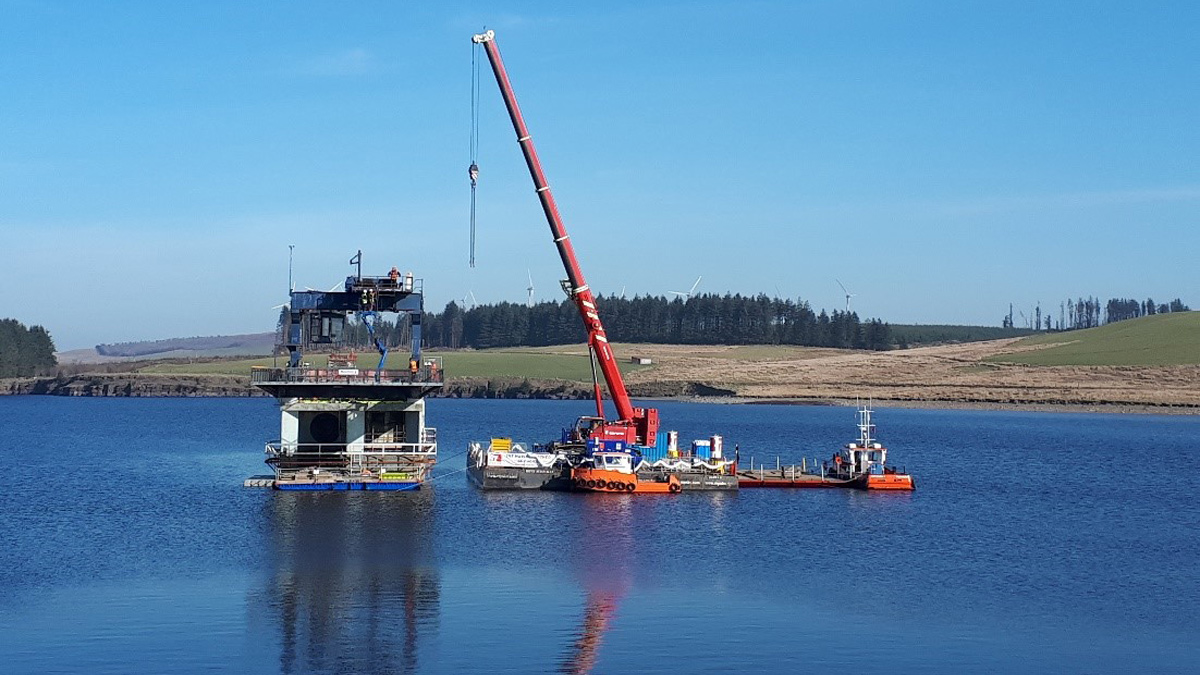
Dismantling original crane – Courtesy of MMB
Scour system works
The activity which posed the greatest health and safety risk was the replacement of the primary scour gate, which involved intrusive concrete removal works to the existing tower whilst working behind a single isolation point from the reservoir. These works were undertaken through the DCWW Gold Command structure.
The greatest risk associated with the work was potential damage to the existing structure which could cause structural failure. This could have been fatal to operatives working within the confined space and also put up to 80,000 downstream residents at risk via an unplanned release of the reservoir. The project team worked closely with Gnat Demolition UK to develop a method to remove the concrete with engineering precision and use of remote/robotic control.
The first indication of any potential damage to the structure or change to its condition was monitoring of the leakage rate past the bulkhead gate. MMB developed a solution in which a robust aluminium screen was installed downstream of the bulkhead gate, creating a protective shield and containment chamber which allowed leakage to be monitored both visually and by use of throttling valves to control the release of leakage. A float switch provided a visual and audible alarm. And 24-hour CCTV monitoring was also in place to assess the work area prior to entry and throughout the working day.
MMB developed a procedure to sufficiently monitor and control all confined space rescue with the provision for emergency rescue and evacuation, and also provided specialist high risk confined spaces training for both site management and site operatives involved in these works.
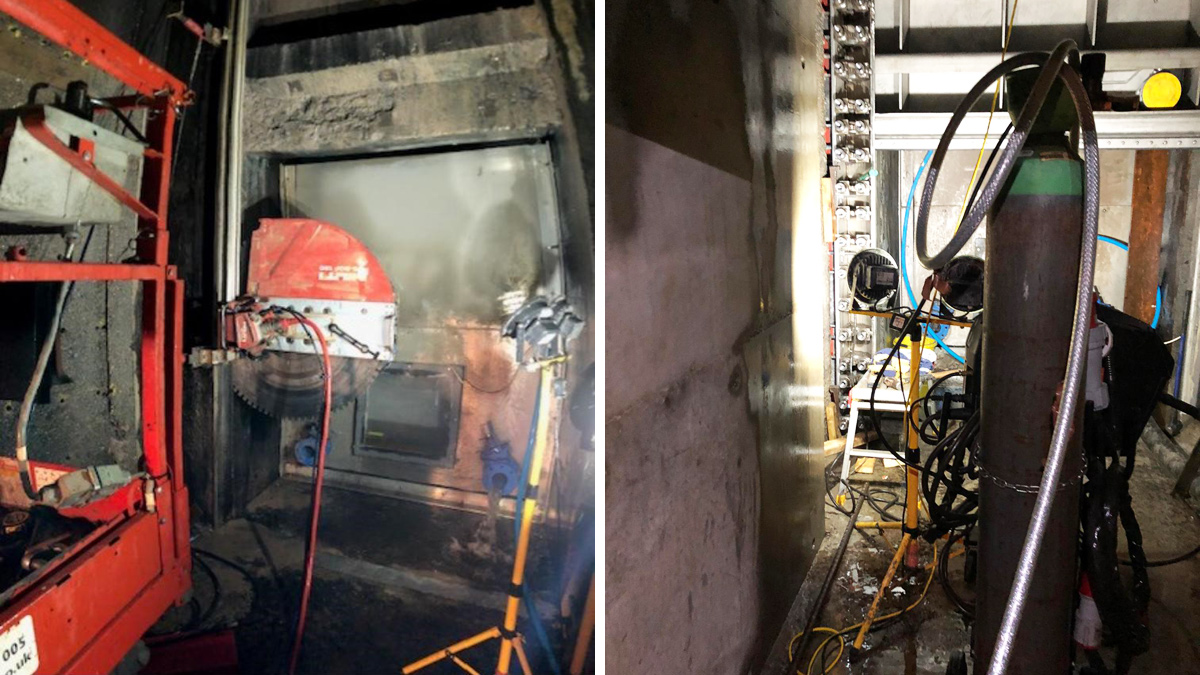
Installation of primary scour gate – Courtesy of MMB and DCWW
Conclusion
The works are now complete and the system is operational. Static testing has been completed for all gates to test under load and for leakage.
The improved scour system offers greater control and safer operation both for frequent tasks and infrequent or emergency situations. The redundancy provided ensures minimum risks to the downstream catchment in the event of an emergency discharge, and the high specification of all new equipment along with the facilitation of safer maintenance and testing procedures will ensure the systems reliability for many years to come.
Works to the main draw-off system, power supplies and control system also improve the everyday operations of the dam and reduce the frequency of confined spaces access.





